Topics
- All India Survey on Higher Education (AISHE)
- CHIME Telescope
- BRICS | Multilateralism
- GST Council
- One Nation One Ration Card scheme
- All India Survey on Higher Education (AISHE)
Context: Recently, the Union Education Minister announced the release of the report of All India Survey on Higher Education (AISHE) 2019-20.
- This Report provides key performance indicators on the current status of Higher education in the country.
- It is the 10th in the series of AISHE annually released by the Department of Higher Education.
Key findings of the report:
- The number of Institutions of National importance increased 80% (from 75 in 2015 to 135 in 2020)
- The number of PhDs has also increased by 60 per cent in the last five years.
- In the last five years from 2015-16 to 2019-20, there has been a growth of 11.4% in student enrolment.
- Uttar Pradesh has highest student enrolment in India (49.1% male and 50.9% female) followed by Tamil Nadu and Maharashtra
- Gross Enrolment Ratio (GER) increased by a minuscule 0.8% in 2019-20.
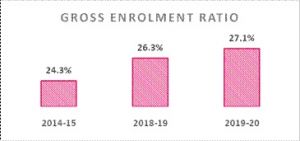
(GER is the number of students enrolled in a given level of education, regardless of age, expressed as a percentage of the official school-age population corresponding to the same level of education).
- The rise in female enrolment in higher education during the period is 18.2%.
- However, share of girl students is lowest in institutes of national importance while female participation in professional courses is lower as compared to academic courses.
- Humanities, Science, Commerce, Engineering & Technology, Medical Science and IT & Computer were six major fields chosen by student
- Total Enrolment in Higher Education stands at 3.85 crore in 2019-20 as compared to 3.74 crore in 2018-19, registering a growth of 11.36 lakh (3.04 %).
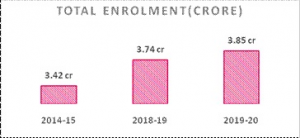
- Gender Parity Index (GPI) in Higher Education in 2019-20 is 1.01 against 1.00 in 2018-19 indicating an improvement in the relative access to higher education for females of eligible age group compared to males.
(A GPI of 1 indicates parity between the sexes; a GPI that varies between 0 and 1 typically means a disparity in favour of males; whereas a GPI greater than 1 indicates a disparity in favour of females.)
- Total Number of Teachers stands at 15,03,156 comprising 57.5% male and 42.5% female.
- Pupil Teacher Ratio in Higher Education in 2019-20 is 26.
- In 2019-20: Universities: 1,043(2%); Colleges: 42,343(77%) and stand-alone institutions: 11,779(21%).
Recent Initiatives with respect to Education in India:
- National Education Policy (NEP), 2020: It aims at increasing the GER in higher education to 50% by 2035.
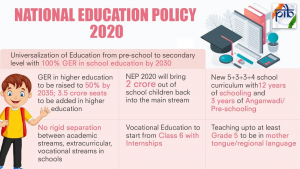
- Scheme for Promotion of Academic and Research Collaboration (SPARC): It aims at improving the research ecosystem of India’s higher educational institutions by facilitating academic and research collaborations between Indian institutions and the best institutions in the world.
- Rashtriya Ucchatar Shiksha Abhiyan (RUSA): It aims at providing strategic funding to higher educational institutions throughout the country.
- CHIME Telescope
Context: Researchers from the Pune-based Tata Institute for Fundamental Research (TIFR) and the National Centre for Radio Astrophysics (NCRA) with Canadian Hydrogen Intensity Mapping Experiment (CHIME) Collaboration have assembled the largest collection of fast radio bursts (FRBs) in the telescope’s first FRB catalogue.
Key Details:
About CHIME:
- It is a novel radio telescope that has no moving parts.
- It is optimized to have a high mapping speed.
- It is located at the Dominion Radio Astrophysical Observatory, Canada.
- CHIME comprises four massive cylindrical radio antennas located at the Dominion Radio Astrophysical Observatory, operated by the National Research Council of Canada.
- The telescope receives radio signals each day from half of the sky as the Earth rotates.
- CHIME focuses incoming signals using a ‘correlator’.
- Correlator is a powerful digital signal processor that can work through huge amounts of data, at a rate of about seven terrabytes per second.
- This enables CHIME to reconstruct and look in thousands of directions simultaneously, helping it detect FRBs a thousand times more often than a traditional telescope.
Observations:
- The telescope has detected 535 new fast radio bursts in its first year of operation itself (2018-2019).
- Most bursts likely originated from far-off sources within distant galaxies.
- Scientists have recorded FRBs that repeat and those that don’t.
- Repeating FRBs last slightly longer and emit more focused radio frequencies than bursts from single, non-repeating FRBs.
- They are evenly distributed in space, seeming to arise from all parts of the sky.
- Scientists calculated that bright fast radio bursts occur at a rate of about 800 per day across the entire sky.
Significance:
- Catching sight of an FRB is considered a rare thing in the field of radio astronomy.
- Prior to the CHIME project, radio astronomers had only caught sight of around 140 bursts in their scopes since the first FRB was spotted in 2007.
- CHIME project has nearly quadrupled the number of fast radio bursts discovered to date.
- They plan to use the bursts, and their dispersion estimates, to map the distribution of gas throughout the universe.
- A defining property of these bursts is their dispersion (scattering or separation), the bursts produce a spectrum of radio waves, and as the waves travel through matter, they spread out or disperse with bursts at higher radio frequencies arriving at telescopes earlier than those at lower frequencies.
- Dispersion can result in signal degradation in many applications, especially over large distances.
- This dispersion allows researchers to learn about two important things:
- They can measure this dispersion to learn about the stuff that radio bursts pass through as they travel toward Earth.
- They can indirectly determine how far apart things are.
- It can be used to understand the three–dimensional structure of matter in the universe and to learn about poorly understood early moments in the evolution of the universe.
Fast Radio Bursts (FRB):
- FRBs are oddly bright flashes of light, registering in the radio band of the electromagnetic spectrum, which blaze for a few milliseconds before vanishing without a trace.
- FRBs have been spotted in various and distant parts of the universe, as well as in the Milky Way. It was first discovered in 2007.
- In 2020, the National Aeronautics and Space Administration (NASA) spotted FRB for the first time in the Milky Way.
- Their origins are unknown and their appearance is highly unpredictable.
- BRICS | Multilateralism
Context: At the end of Virtual BRICS Foreign Ministers meeting which was held recently, two statements were issued on the “Meeting of the BRICS Ministers of Foreign Affairs/International Relations” and another on “BRICS Joint Statement on Strengthening and Reforming the Multilateral System”.
Highlights:
- For the first time, BRICS foreign ministers have agreed on a common, standalone joint statement on reforming the multilateral system.
- They have also agreed that such reform has to cover all key multilateral institutions, including the UN and its principal organs, international financial architecture (IMF, World Bank), multilateral trading system (WTO, UNCTAD) and the global health governance system with the WHO at its core.
- In particular, BRICS ministers agreed to instil new life in the discussions on reform of UN Security Council.
- All BRICS countries called for supporting ongoing consideration in WTO on a Covid-19 vaccine Intellectual Property Rights waiver and the use of flexibilities of the TRIPS agreement and the Doha Declaration on TRIPS Agreement and Public Health.
- To improve global economic governance, seen as a key for a quick economic turnaround in the post covid-19 world, BRICS ministers reaffirmed their support for a transparent, rules-based, open, inclusive and non-discriminatory multilateral trading system, with the World Trade Organization at its core.
- The BRICS FMs have agreed to a set of six principles that should guide the reform of multilateral institutions.
Principles laid out by BRICS for the task of Strengthening and Reforming the Multilateral System:
- It should make instruments of global governance more inclusive, representative and participatory to facilitate greater and more meaningful participation of developing and least developed countries in decision making.
- It should be based on inclusive consultation and collaboration for the benefit of all.
- It should make multilateral organisations more responsive, action-oriented and solution-oriented based on the norms and principles of international law and the spirit of mutual respect, justice, equality, and mutually beneficial cooperation.
- It should use innovative and inclusive solutions, including digital and technological tools.
- It should strengthen the capacities of individual States and international organizations.
- It should promote people-centred international cooperation at the core.
Multilateralism:
- It is the process of organizing relations between groups of three or more states.
- Multilateralism is generally considered to comprise certain qualitative elements or principles that shape the character of the arrangement or institution. Those principles are:
- Indivisibility of interests among participants.
- Commitment to diffuse reciprocity, i.e. mutual exchange.
- System of dispute settlement intended to enforce a particular mode of behaviour.
Significance:
- Multilateral institutions have played a significant role in post-war global governance and are arguably more stable than other forms of organization because the principles underlying them appear to be more durable and more able to adapt to external changes.
Why multilateralism matters for BRICS:
- ‘strengthening and reforming the multilateral system’ remains a key principle of cooperation among BRICS, as is evident from the 2019 Brasilia summit declaration.
- Given that BRICS countries on their own are not in a position to mount global efforts to deal with large-scale crisis, a paralysis at the level of other multilateral institutions negatively affects agenda formation in BRICS.
- The ongoing churn in the world order, further complicated by the pandemic sweeping through the world, has however raised concerns about future policy directions of BRICS member states and its eventual impact on the organisation as a whole.
- If the US-China rivalry intensifies, the already complex dynamics between India and China, India’s balancing act with the US, the growing Russia-China linkages, Russia-US tensions — raise the prospects of an ‘internal split.’
Need of multilateralism:
- Misuse of existing International and national laws by several countries (via forced technology requirements, intellectual property rights violations, and subsidies), to gain an unfair advantage over other countries.
- The imposition of extraterritorial sanction (under CAATSA) by the US has affected development in developing economies like India and China.
- Paralysis of the World Trade Organization (WTO), due to the tussle between the developed and developing world.
- Some of the developed countries have jurisdiction and control over global supply chains. Due to growing convergence between commercial interests and strategic goals, these supply chains enable them to have vast extraterritorial influence and have created new power asymmetries.
- China through BRI (Belt and Road Initiative) is enhancing its role in global economic governance.
- There are fears pertaining to dual-use (commercial viability and military application) of Industrial Revolution 4.0.
- Also, due to the lack of any global public health framework, Covid-19 has spread into a pandemic.
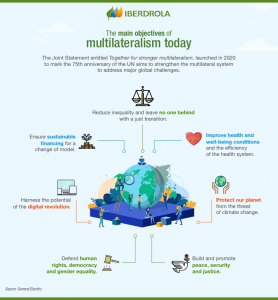
BRICS:
- BRICS is an acronym for the grouping of the world’s leading emerging economies, namely Brazil, Russia, India, China and South Africa.
- India has assumed the BRICS Presidency from January 2021.
- BRICS does not exist in the form of organization, but it is an annual summit between the supreme leaders of five nations.
- The Chairmanship of the forum is rotated annually among the members, in accordance with the acronym B-R-I-C-S.
4.GST Council
Context: Recently, 44th GST Council meeting was conducted under the chairmanship of Union Finance minister Nirmala Sitharaman
Key decisions that were taken during the 44th GST Council meeting:
- The GST Council has agreed to stick to 5 per cent tax rate on vaccines.
- GST rates on Tocilizumab and Amphotericin B have been slashed to nil from 5 per cent. The rate on Remdesivir and anti-coagulants like Heparin has been lowered from 12 per cent to 5 per cent.
- Tax on medical grade oxygen, oxygen concentrators, ventilators, BiPAP machines and high flow nasal cannula (HFNC) devices has been cut to 5 per cent from 12 per cent.
- Tax on Covid testing kits has been brought down to 5 per cent from 12 per cent.
- Pulse oximeters, hand sanitisers, temperature check equipment and ambulances too will attract lower 5 per cent tax.
- These GST rate reductions shall remain in force till September 30, 2021.
- The decisions taken during the meeting of the GST Council were based on the recommendations of the Group of Ministers (GoM). It was formed after the last GST Council meeting on May 28 to deliberate on possible reductions in COVID-related items.
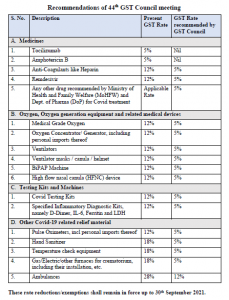
GST Council:
- It is a constitutional body under Article 279A. It makes recommendations to the Union and State Government on issues related to Goods and Service Tax and was introduced by the Constitution (One Hundred and First Amendment) Act, 2016.
- The GST Council is chaired by the Union Finance Minister and other members are the Union State Minister of Revenue or Finance and Ministers in-charge of Finance or Taxation of all the States.
- It is considered as a federal body where both the centre and the states get due representation.
- Every decision of the Goods and Services Tax Council shall be taken at a meeting by a majority of not less than three-fourths of the weighted votes of the members present and voting, in accordance with the following principles, namely:
- the vote of the Central Government shall have a weightage of one third of the total votes cast, and
- the votes of all the State Governments taken together shall have a weightage of two-thirds of the total votes cast, in that meeting.
5.One Nation One Ration Card scheme
Context: The Supreme Court has asked the West Bengal government to implement the One Nation One Ration Card scheme “immediately” to help beneficiaries, especially migrant workers, to avail of subsidised food commodities from anywhere in the country.
- Apart from West Bengal, Assam, Chhattisgarh and Delhi are the other states yet to implement it.
Background:
- The court is hearing a suo motu (registered on its own motion) case pertaining to “problems and miseries of migrant workers”.
What is the one ‘One Nation, One Ration Card’ system?
- Under the National Food Security Act, 2013, about 81 crore persons are entitled to buy subsidized food grain from their designated Fair Price Shops (FPS) of the Targeted Public Distribution System (TPDS).
- Under the system, existing ration cards will be turned as one nation one ration card.
- It will be a universal ration card allotted to each beneficiary registered under NFSA.
- Using the ONORC, a beneficiary who migrates from one place to another can buy subsidized food grains from the fair price shop located in the destination city regardless of the origin of the beneficiaries.
- Currently, about 23 crore ration cards have been issued to nearly 80 crore beneficiaries of NFSA in all states and UTs.
- Benefits:
- Ration card portability is aimed at providing intra-state as well as inter-state portability of ration cards.
- No poor person is deprived of getting subsidised food grains under the food security scheme when they shift from one place to another. It also removes the chance of anyone holding more than one ration card to avail benefits from different states.
- This will provide freedom to the beneficiaries as they will not be tied to any one PDS shop and reduce their dependence on shop owners and curtail instances of corruption.
- It will be particularly beneficial for women and other disadvantaged groups, given how social identity (caste, class and gender) and other contextual factors (including power relations) provide a strong backdrop in accessing PDS.
- This will help achieve the target set under SDG 2: Ending hunger by 2030. Also, it will address the poor state of hunger in India, as highlighted by the Global Hunger Index, where India has been ranked 102 out of 117 countries.
Standard format of ‘one nation, one ration card’:
- For national portability, the state governments have been asked to issue the ration card in bi-lingual format, wherein besides the local language, the other language could be Hindi or English.
- The states have also been told to have a 10-digit standard ration card number, wherein first two digits will be state code and the next two digits will be running ration card numbers.
- Besides this, a set of another two digits will be appended with ration card number to create unique member IDs for each member of the household in a ration card.
- The Annavitran portal enables a migrant worker or his family to avail the benefits of PDS outside their district but within their state.
- Integrated Management of Public Distribution System (IM-PDS) portal provides the technological platform for the inter-state portability of ration cards, enabling a migrant worker to buy food grains from any FPS across the country.
Challenges:
- Exclusion Error: The digitisation of this PDS process, through Aadhaar-linked ration cards and smart cards, has been pushed in an effort to reduce leakages. However, there has been a rise of exclusion errors in post-Aadhaar seeding.
- There are many sections of society who still don’t have Aadhar Card, thereby depriving them of food security.
- The fears of exclusion are also applied for migrant workers, as the fingerprints of people engaged in construction labour and domestic work may change or fade and may not match with the ones entered in Aadhar.
- Logistical Issues: An FPS receives the monthly quota of products strictly in accordance with the number of people assigned to it.
- The ONORC, when fully operational, would disrupt this practice, as some FPSs may have to cater to more numbers of cards even as others cater to less, owing to migration of people.
- Lack of Data: There is no exact data on the mobility of poor households migrating to work, locating intra- and inter-state destinations and sectors employing the workers.
